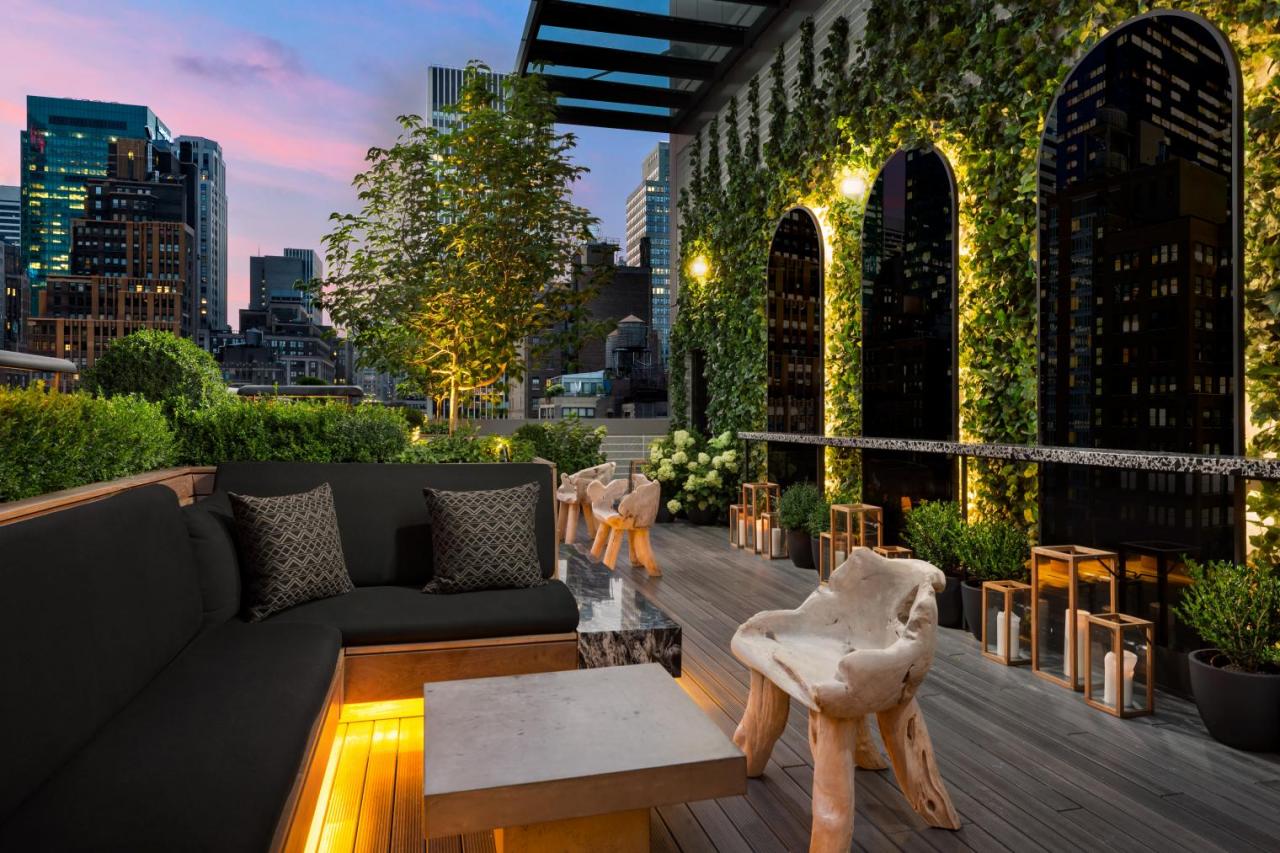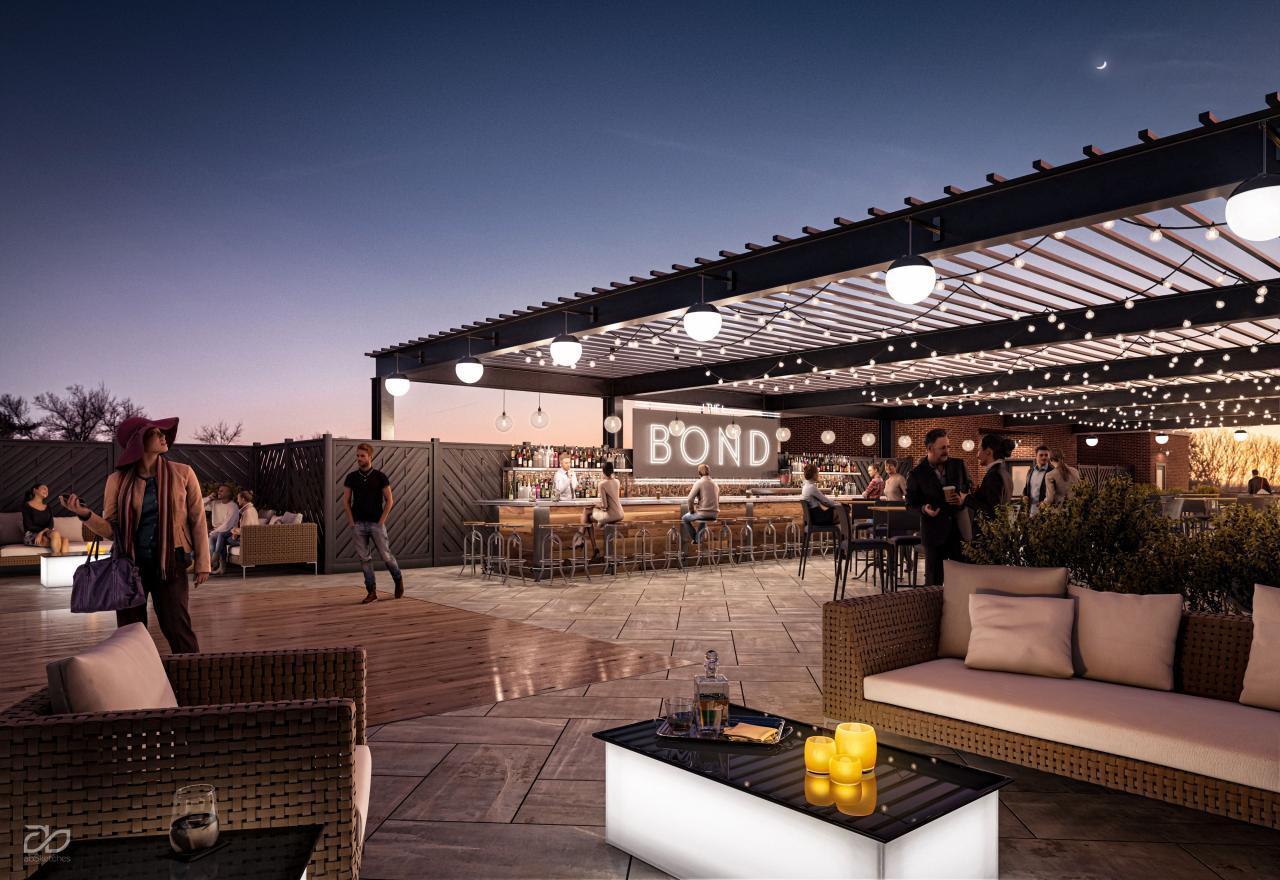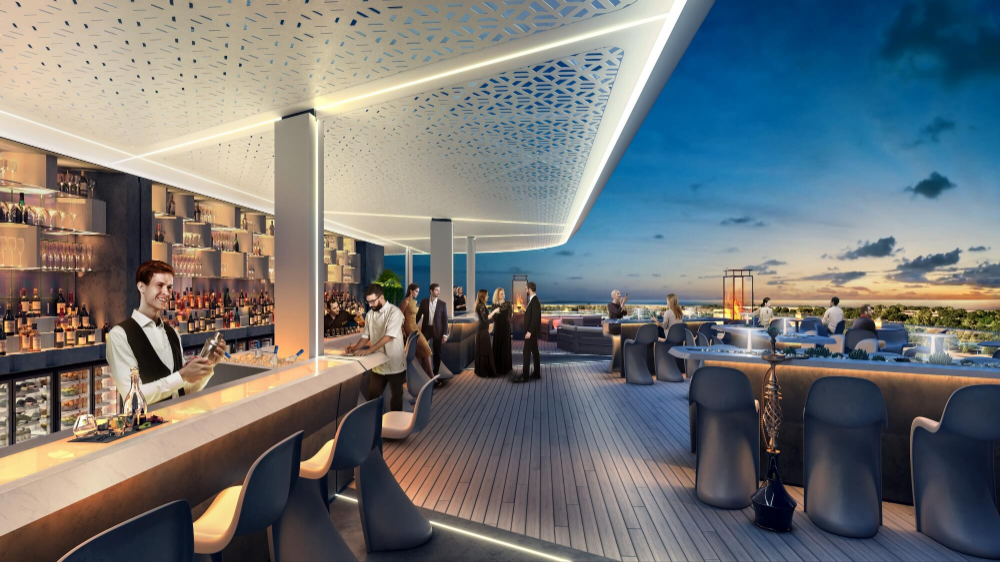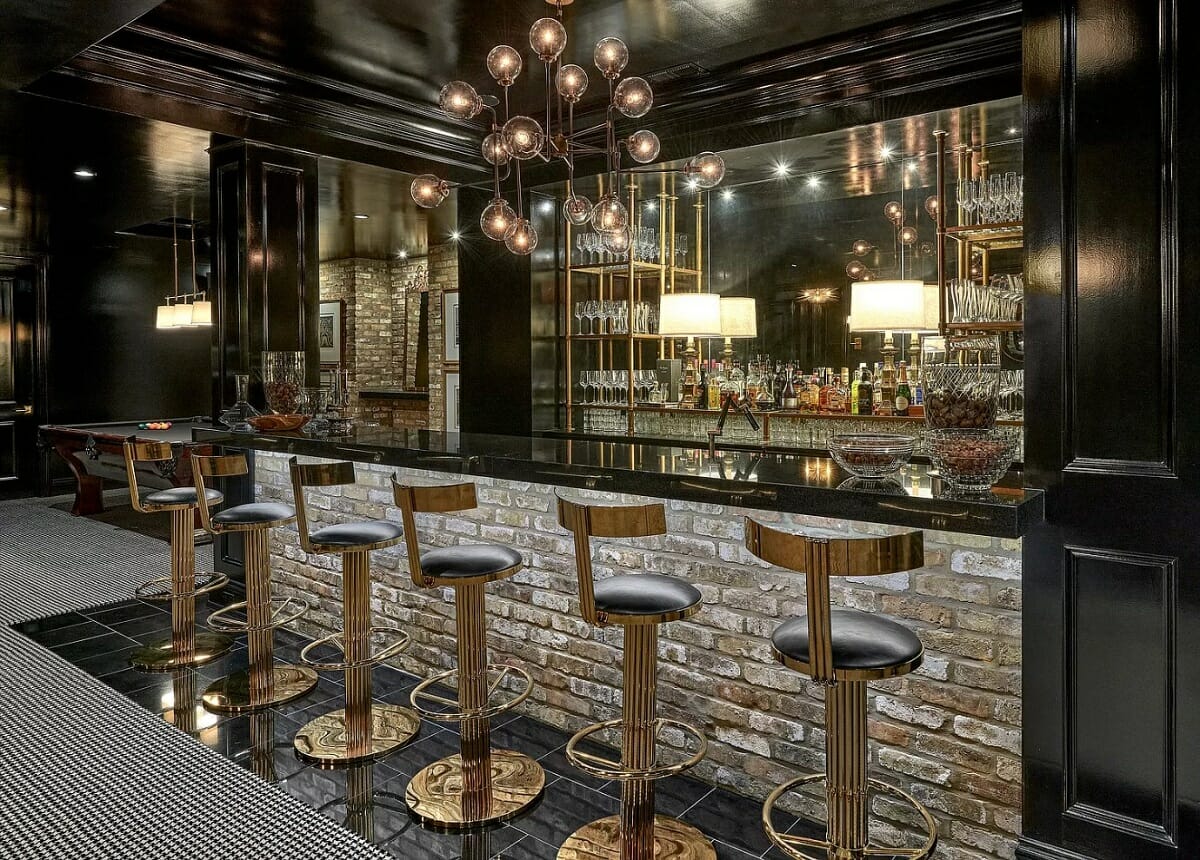Rooftop bar design ideas for creating a unique and inviting atmosphere are trending! Transforming a rooftop space into a vibrant and memorable destination requires careful planning and a keen eye for detail. From defining your unique selling proposition (USP) and target audience to selecting the perfect materials and lighting, every element plays a crucial role in crafting an unforgettable experience.
Let’s dive into the key design elements that will set your rooftop bar apart from the rest.
This journey explores everything from crafting a captivating ambiance with strategic lighting and carefully chosen materials, to maximizing stunning views and incorporating weather-resistant features for year-round enjoyment. We’ll also delve into the importance of space planning, ensuring smooth traffic flow and diverse seating arrangements to cater to every guest. Get ready to elevate your rooftop bar concept to new heights!
Defining the Unique Selling Proposition (USP)

Crafting a truly unique rooftop bar requires more than just a stunning view; it demands a distinct identity that resonates with a specific target audience. This involves identifying a niche, understanding consumer preferences, and translating that understanding into a cohesive design concept that sets your establishment apart from the competition. A well-defined USP will not only attract customers but also cultivate brand loyalty and ensure long-term success.The key to defining a compelling USP lies in understanding your target market.
Designing a killer rooftop bar? Ambiance is everything! Consider incorporating unique lighting, comfy seating, and maybe even a fire pit for that extra touch of warmth. For menu inspiration, check out the offerings at rh rooftop menu edina ; their choices could spark some creative ideas for your own drink and food selections. Ultimately, a well-designed rooftop bar should offer a memorable experience, leaving guests wanting more.
Who are you trying to attract? What are their lifestyle preferences, spending habits, and expectations? Are you targeting young professionals seeking a vibrant social scene, discerning couples looking for a romantic ambiance, or perhaps a more mature crowd appreciating sophisticated cocktails and live music? Thorough market research and competitor analysis are crucial steps in this process. By identifying unmet needs or underserved segments within the market, you can position your rooftop bar to fill a gap and stand out from the crowd.
Design Themes and Target Demographics
Three distinct design themes can cater to different target demographics and create unique experiences. Each theme carefully considers the target audience’s preferences, creating a space that reflects their lifestyle and aspirations.
Theme 1: The Bohemian Oasis
This theme evokes a relaxed, artistic atmosphere. Imagine lush greenery cascading from hanging planters, comfortable bohemian-style seating arrangements with plush cushions and throws, and eclectic lighting fixtures creating a warm, inviting glow. The color palette would be earthy and natural, with textures like woven fabrics and natural wood adding to the organic feel. This design would appeal to a younger, creative crowd, perhaps students, artists, and free-spirited individuals who value authenticity and community.
The drinks menu could feature handcrafted cocktails with fresh, seasonal ingredients, and the music would be a mix of chillwave, indie folk, and acoustic sets.
Theme 2: The Urban Jungle
This theme embraces a modern, sophisticated aesthetic with a touch of nature. Think sleek, minimalist furniture, interspersed with large potted plants and vertical gardens creating a sense of tranquility within the bustling city. The color scheme would be neutral and elegant, with pops of vibrant green and metallic accents. This design would attract a more affluent clientele, young professionals, and those seeking a stylish yet relaxed atmosphere.
The cocktail menu would feature expertly crafted signature drinks, and the music could be a curated mix of electronic music, jazz, and chill-out lounge vibes.
Theme 3: The Celestial Lounge
This theme offers a glamorous, otherworldly experience. The design incorporates celestial elements, such as star-shaped lighting, shimmering fabrics, and deep blues and purples in the color palette. The furniture would be plush and luxurious, perhaps with velvet upholstery and metallic accents. This theme would attract a more upscale, sophisticated crowd seeking a unique and memorable experience. The cocktail menu would feature innovative, visually stunning drinks, and the music would be a blend of smooth jazz, electronic music, and perhaps even live performances by a string quartet or a DJ.
Crafting the perfect rooftop bar involves more than just stunning city views; it’s about curating an experience. Consider unique lighting, comfortable seating, and a killer menu to set the mood. For inspiration on elevating your food and drink offerings, check out the creative dishes featured on the rhinoceros rooftop menu ; it’s a great example of how a thoughtful menu can enhance the overall ambiance.
Ultimately, a memorable rooftop bar experience is a blend of thoughtful design and delicious offerings.
Space Planning and Layout

Creating a captivating rooftop bar experience hinges on thoughtful space planning. The layout must seamlessly blend functionality with aesthetic appeal, ensuring comfortable guest flow and a visually stunning environment. Careful consideration of furniture placement, traffic patterns, and the strategic positioning of key features are crucial to achieving a truly unique and inviting atmosphere.A well-designed floor plan is essential for optimizing space and creating a dynamic flow.
The arrangement of furniture should facilitate easy movement while simultaneously offering diverse seating options to cater to various group sizes and preferences. Key features, such as the bar, restrooms, and any unique design elements, should be strategically placed to enhance the overall experience and create visual interest.
Rooftop Bar Floor Plan
The following table illustrates a sample floor plan, showcasing optimal furniture arrangement for a medium-sized rooftop bar. Remember that this is a template, and the specific layout will need to be adapted based on the unique dimensions and characteristics of the actual rooftop space.
| Area | Furniture | Capacity | Notes |
|---|---|---|---|
| Main Bar Area | Bar counter with high stools, several small cocktail tables | 20-25 | Strategically placed to provide a central focal point and easy access to drinks. |
| Lounge Area | Comfortable sofas and armchairs arranged in intimate groupings, low coffee tables | 15-20 | Creates a relaxed and conversational atmosphere. |
| Dining Area | Several large communal tables, some smaller tables for two | 30-40 | Caters to larger groups and offers a more formal dining experience. |
| Outdoor Patio | Comfortable wicker chairs and sofas, fire pits | 20-25 | Provides a cozy and intimate outdoor seating area, particularly appealing in cooler evenings. |
| Restrooms | Men’s and women’s restrooms | N/A | Conveniently located and easily accessible. |
Seating Arrangements
Offering diverse seating options is key to accommodating varied group sizes and preferences. This ensures that all guests feel comfortable and can find a space that suits their needs.
- Intimate booths: These provide a sense of privacy and seclusion, ideal for couples or small groups seeking a more intimate setting. Consider booth seating along the walls or strategically placed throughout the space. Imagine plush velvet upholstery and soft lighting to enhance the ambiance.
- Large communal tables: These are perfect for larger groups of friends or colleagues, encouraging a lively and social atmosphere. These tables can be placed in the center of the room or near windows for optimal views.
- Bar seating: High stools at the bar offer a vibrant and energetic atmosphere, ideal for those who want to be part of the action and easily interact with bartenders. The bar itself can be designed as a visual centerpiece, showcasing creative cocktails and high-quality spirits.
- Outdoor seating: Comfortable lounge seating on the patio provides a more relaxed atmosphere, allowing guests to enjoy the fresh air and city views. Consider fire pits or heaters for added comfort during cooler evenings. This could feature plush cushions and throws for a luxurious feel.
Placement of Key Features
The strategic placement of key features significantly impacts the overall ambiance and functionality of the rooftop bar.The bar itself should be a focal point, ideally positioned to offer a clear view of the entire space. Restrooms should be easily accessible yet discreetly placed. Unique design elements, such as fire pits or water features, can be used to create visual interest and enhance the atmosphere.
For example, a strategically placed water feature could provide a calming and soothing element, while fire pits could create a warm and inviting ambiance, particularly during the cooler months. These features should be placed to avoid obstructing traffic flow or creating safety hazards.
Ambiance and Lighting Design

Crafting the perfect ambiance in a rooftop bar is crucial; it’s the invisible hand that guides the guest experience, transforming a simple space into a memorable destination. Lighting plays a pivotal role in this transformation, setting the mood and shaping the perception of the entire venue. A well-executed lighting plan considers the time of day, the desired atmosphere, and the functionality of different areas.The strategic use of lighting – ambient, task, and accent – is key to creating a multi-layered and captivating environment.
Ambient lighting provides a general illumination, setting the overall tone. Task lighting focuses on specific areas, ensuring functionality and visibility. Accent lighting, meanwhile, highlights architectural features or decorative elements, adding depth and visual interest. By carefully balancing these three types of lighting, you can create a dynamic and inviting space that evolves throughout the day and night.
Lighting Schemes for Different Times of Day
Sunset, evening, and nighttime each demand a unique lighting approach to maximize the rooftop bar’s appeal. During sunset, warm, golden hues can be emphasized, mimicking the natural light and creating a romantic and relaxed atmosphere. As evening progresses, a shift towards softer, dimmer lighting can foster a more intimate and sophisticated ambiance. Finally, at night, a blend of brighter and darker areas can be used to create visual interest and guide guest movement.
Imagine the warm glow of strategically placed lanterns contrasted against the city lights twinkling in the distance. This contrast adds a layer of intrigue and visual appeal, transforming the rooftop into a captivating urban oasis.
Contribution of Different Lighting Types to Ambiance
Ambient lighting sets the foundational mood. Think soft, diffused light from recessed fixtures or strategically placed pendants, creating a welcoming and comfortable glow throughout the space. Task lighting, on the other hand, ensures practicality. Well-lit bar counters, tables, and walkways improve functionality and guest safety. Accent lighting, often using spotlights or LED strips, elevates the design.
It highlights architectural details like exposed beams or the bar’s unique features, adding depth and visual interest to the overall aesthetic. For instance, accent lighting could subtly illuminate a living wall, showcasing its vibrant greenery and adding a touch of nature to the urban setting.
Lighting Plan Example
A successful lighting plan needs to consider various zones and their specific functions. Here’s a sample plan:
- Area: Seating Area near the bar. Fixture Type: Pendant lights with warm-white LED bulbs. Placement: Above seating groups, spaced evenly. Mood: Intimate and comfortable, encouraging conversation.
- Area: Bar counter. Fixture Type: Linear LED strip lighting under the counter, plus adjustable spotlights above the bar back. Placement: Underneath the counter for task lighting, spotlights to highlight bottles and bar features. Mood: Functional and visually appealing, showcasing the bar’s offerings.
- Area: Lounge Area. Fixture Type: Floor lamps with adjustable brightness and warm-toned bulbs. Placement: Strategically placed among seating arrangements. Mood: Relaxed and inviting, perfect for lounging and socializing.
- Area: Outdoor Seating. Fixture Type: String lights with warm-white bulbs and strategically placed uplighting on nearby buildings. Placement: Draped across the seating area, uplighting to enhance the cityscape. Mood: Romantic and magical, emphasizing the rooftop’s location.
- Area: Dance Floor (if applicable). Fixture Type: RGB LED spotlights with dynamic lighting capabilities. Placement: Positioned to wash the dance floor with vibrant color. Mood: Energetic and exciting, encouraging movement and dancing.
Material Selection and Decor: Rooftop Bar Design Ideas For Creating A Unique And Inviting Atmosphere
Crafting a truly unforgettable rooftop bar experience hinges on meticulous material selection and a cohesive decor scheme. The right materials not only withstand the elements but also contribute significantly to the overall ambiance, reflecting the bar’s unique personality and enhancing the guest experience. A carefully curated decor, seamlessly integrating furniture, artwork, and landscaping, elevates the space from functional to phenomenal.The choice of materials is crucial for a rooftop bar, balancing durability against aesthetic appeal.
Exposure to sun, wind, and rain necessitates the use of weather-resistant materials that can withstand the rigors of outdoor use while maintaining their visual integrity. Similarly, the decor must create a welcoming and stylish atmosphere, reflecting the bar’s intended vibe and attracting its target clientele.
Material Choices for Rooftop Bars
Selecting materials for a rooftop bar requires careful consideration of both functionality and aesthetics. Durability is paramount given the outdoor setting, while the chosen materials should also contribute to the desired ambiance.
- Wood: Ipe, teak, or cedar are excellent choices for their weather resistance and natural beauty. They can be used for flooring, furniture (tables, chairs, bar counters), and accent pieces, adding warmth and sophistication. Consider using treated wood to enhance its longevity and resistance to rot and insects.
- Metal: Powder-coated steel or aluminum offer durability and modern aesthetics. These are ideal for furniture frames, railings, and decorative accents. The powder coating provides protection against corrosion and fading. Consider using wrought iron for a more rustic or vintage feel.
- Stone: Natural stone like granite or slate provides a luxurious and durable surface for flooring, countertops, and wall cladding. Its inherent strength and resistance to weathering make it a practical choice for outdoor applications. The natural variations in color and texture add a unique character to the space.
- Fabric: Outdoor-grade fabrics, such as Sunbrella or solution-dyed acrylics, are essential for upholstery and cushions. These fabrics resist fading, mildew, and water damage, ensuring the longevity of furniture and maintaining a clean, fresh look. Choose fabrics that complement the overall color scheme and theme of the bar.
Decor Scheme and Elements, Rooftop bar design ideas for creating a unique and inviting atmosphere
The decor scheme should be a cohesive extension of the rooftop bar’s theme and USP. For instance, a sophisticated cocktail bar might feature sleek, modern furniture in dark wood and metal, complemented by subtle lighting and abstract artwork. A more relaxed, bohemian bar might opt for wicker furniture, vibrant textiles, and eclectic artwork.For a tropical-themed rooftop bar, imagine rattan furniture arranged around low tables, interspersed with lush potted plants.
The walls could be adorned with vibrant artwork depicting tropical landscapes or flora, while string lights and lanterns add a warm, inviting glow. The bar itself could be crafted from reclaimed wood, adding a touch of rustic charm.
Landscaping and Plant Selection
Incorporating plants and landscaping is crucial for creating a visually appealing and relaxing atmosphere on a rooftop bar. Plants soften the hard lines of the architecture, provide shade, and improve air quality. Careful selection of plant types is essential to ensure they thrive in the rooftop environment.Consider using drought-tolerant plants and those that can withstand varying temperature fluctuations.
Large potted trees, such as olive trees or Japanese maples, can create focal points, while smaller plants and flowers in various containers add pops of color and texture. Trailing plants can be used to soften the edges of railings or walls, creating a lush, verdant backdrop. Strategically placed vertical gardens can also maximize space and enhance the overall aesthetic.
For instance, a mix of succulents, herbs, and flowering plants would add visual interest and potentially even offer fresh ingredients for cocktails.
View Integration and Outdoor Elements
A rooftop bar’s success hinges on its breathtaking views. Maximizing this asset requires careful consideration of design elements that seamlessly blend the indoor and outdoor spaces, creating a cohesive and unforgettable experience for patrons. Strategic placement of windows, thoughtful outdoor seating arrangements, and the incorporation of eye-catching outdoor features all play a crucial role in achieving this.The key is to frame the view.
Avoid obstructing the panorama with bulky furniture or poorly placed structures. Instead, design the space to direct the eye towards the most stunning aspects of the cityscape or landscape. This involves not only window placement but also the strategic use of mirrors, strategically placed lighting, and even the careful selection of plant life to enhance, rather than detract from, the view.
Window Placement and Outdoor Seating
Large, floor-to-ceiling windows are a must, ideally extending from the interior seating area to the outdoor terrace. This creates a sense of fluidity and allows for uninterrupted views from almost every vantage point. Consider using frameless glass to minimize visual obstructions and maximize the feeling of openness. Outdoor seating should be arranged to maximize view lines, with individual seating areas or groupings positioned to offer different perspectives.
For instance, some seating could be oriented towards a specific landmark, while other areas could offer a broader, panoramic view. The furniture itself should be chosen to complement the overall aesthetic and not compete with the view. Think sleek, modern designs in neutral colors that allow the scenery to take center stage.
Fire Pit Design and Placement
A centrally located, 6-foot diameter circular fire pit crafted from reclaimed corten steel would serve as a striking focal point. The corten steel’s natural rust patina would develop over time, adding to its rustic charm and blending seamlessly with a modern industrial aesthetic. The fire pit would be surrounded by comfortable, low-slung seating made from weather-resistant wicker, arranged in a semi-circular formation to encourage conversation and create a sense of intimacy.
Its placement would be carefully considered to ensure it doesn’t obstruct the view, potentially nestled amongst strategically placed planters filled with drought-tolerant grasses and succulents. The fire pit’s height would be approximately 18 inches from the ground, ensuring comfortable access and visual appeal. The inclusion of gas-powered ignition would make it easy to light and control, while embedded LED lighting around the base would add ambiance after sunset.
Weather Protection Strategies
Year-round usability is crucial for a rooftop bar’s financial success. Retractable awnings, made from a high-quality, weather-resistant fabric, would offer protection from sun and rain. These awnings could be automated for easy operation, responding to changes in weather conditions. For colder months, strategically placed infrared heating systems would provide warmth without taking up valuable space or impacting the aesthetic appeal.
These could be discreetly integrated into the ceiling structure or incorporated into the design of the outdoor furniture. Additionally, windbreaks, perhaps constructed from sleek, translucent panels, could be employed to mitigate the effects of strong winds, ensuring a comfortable experience regardless of the weather. Consider incorporating heated flooring for an extra layer of comfort during colder months.
Illustrative Descriptions (Visual Elements)

Crafting a truly memorable rooftop bar experience hinges on the meticulous attention to visual detail. Every element, from the bar itself to the panoramic vista, contributes to the overall atmosphere and should be carefully considered to create a unique and engaging space. The following descriptions aim to paint a vivid picture of potential visual elements that could elevate your rooftop bar design.
The Sculptural Bar
Imagine a bar crafted from reclaimed teak wood, its surface a rich tapestry of warm browns and honeyed golds, subtly contrasting with the dark grey, almost black, steel supports that rise elegantly to a height of five feet. The wood, meticulously polished, possesses a smooth, almost silken texture, while the steel offers a cool, industrial counterpoint. The bar’s overall form is gently curved, almost sculptural, with integrated lighting subtly illuminating the rich grain of the wood.
It measures approximately 30 feet in length, providing ample space for both seating and bartending. The back bar features a stunning display of artisanal spirits, their labels gleaming under soft, focused lighting. The entire structure exudes a sense of refined rusticity, blending the warmth of natural materials with the sleekness of modern design.
Panoramic Cityscape at Night
From the rooftop terrace, the city unfolds like a breathtaking panorama. A million pinpricks of light twinkle below, blurring into a soft, shimmering tapestry. The iconic skyline, punctuated by towering skyscrapers and shimmering glass facades, is framed by the velvety black of the night sky. The sounds of the city – the distant hum of traffic, the laughter of passersby, the occasional siren wail – are muted and distant, contributing to a sense of calm amidst the urban energy.
The gentle breeze carries the subtle scent of city rain and distant flowers, creating a sensory experience that is both invigorating and calming. The moon, a luminous orb, casts a soft glow on the cityscape, painting the scene in silvery hues.
Lounge Area Texture and Materials
The lounge area is a haven of plush comfort and sophisticated textures. Deep, plush velvet sofas in shades of deep teal and charcoal grey invite guests to relax. The velvet’s soft, yielding texture is a tactile delight, contrasting beautifully with the cool smoothness of the polished concrete floor. Large, intricately woven wool rugs in muted earth tones anchor the seating areas, adding warmth and visual interest.
Low-slung, brushed brass coffee tables provide a touch of metallic glamour, reflecting the ambient lighting and creating a subtle shimmer. The overall effect is one of luxurious serenity, where the interplay of textures and materials creates a space that is both visually striking and incredibly comfortable.